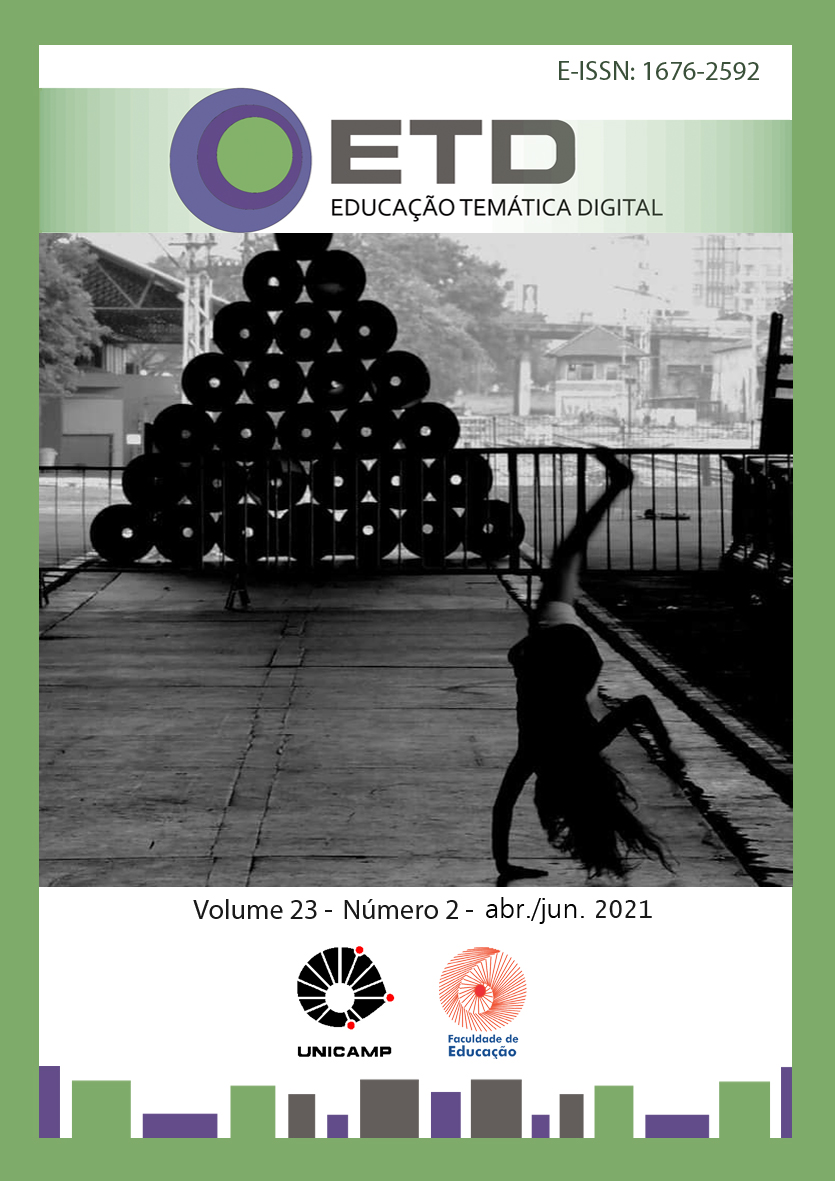Abstract
The requirement to display at least two hours a month of Brazilian films at school has brought up the discussion about how (and if) cinema has been used in schools. In 2016, research professors from the International Image, Geography and Education Research Network proposed a survey common to all the Network's centers (Brazil, Argentina and Colombia), through a basic questionnaire, in order to find out how Geography teachers were appropriating this new possibility in education. Which motivations lead teachers to show films in class? Which films are these and which geographical content are being raised? To understand the possible answers to these questions, we investigated the responses of 136 Brazilian teachers. Firstly, we consider the power of images and the reflections about them in geographic education, as well as working with a theoretical framework that is capable of thinking about the visibility regime that involves the presentation of films as a didactic resource or as an object of cultural expansion of students. Second, when dealing with the results of the research, we problematize the motivations for cinema at school, showing recurrences of themes, contents and films cited by the teachers, questioning the role of some spaces. In this sense, we observe how the films have the power to mark the geographic and cultural imagery of the students and, from there, we pay attention to the need to discuss the films presented, showing them as one of the points of view of reality, but not the only.
References
CHAVES, Ana Paula Nunes; PREVE, Ana Maria Hoepers. Sobre cinema e geografia na escola: algumas aproximações de pesquisa. In: ENCONTRO NACIONAL DE PRÁTICA DE ENSINO EM GEOGRAFIA, 14., 2019, Campinas, SP. Anais do XIV ENPEG, Campinas, SP, 2019. p. 2240-2251.
COSGROVE, Denis. Appolo’s eye: a cartography genealogy of the earth in the western imagination. Baltimore: Johns Hopkins University Press, 2001.
COSGROVE, Denis. Contested global visions: one-world, whole-earth, and the apollo space photographs. Annals of the Association of American Geographers, v. 84, n. 2, p.270-294, 1994.
COSGROVE, Denis. Geography & vision: seeing imagining and representing the world. London, I.B.: Tauris, 2008.
DIDI-HUBERMAN, G. Quando as imagens tocam o real. Pós, v.2, n.4, p. 204-219, 2012.
DUSSEL, Inés. Escuela y cultura de la imagen: los nuevos desafios. Nómadas, Universidad Central - Colombia, n. 30, p. 180-193, 2009.
FISCHER, Rosa Maria Bueno. El ejercicio de ver: medios y educación. In: DUSSEL, Inés; GUTIERREZ, Daniela (Org.). Educar la mirada: políticas y pedagogías de la imagen. Buenos Aires: Manancial, OSDE, 2006. p. 165-177.
FISCHER, Rosa Maria Bueno. Problematizações sobre o exercício de ver: mídia e pesquisa em educação. Revista Brasileira de Educação, Rio de Janeiro, n. 20, p. 83-94, 2002.
GOMES, Paulo Cesar da Costa. O lugar do olhar: elementos para uma geografia da visibilidade. Rio de Janeiro: Bertrand Brasil, 2013.
GREGORY, Derek. Geographical imaginations. Oxford: Blackwell, 1998.
HOLLMAN, Verónica Carolina. Los contextos de las imágenes: un itinerario metodológico para la indagación de lo visual. Espaço e Cultura, Rio de Janeiro, n.36, p. 61-83, 2014.
HOLLMAN, Verónica Carolina. Geografía y cultura visual: apuntes para la discusión de uma agenda de indagación. Estudios Socioterritoriales Revista de Geografia, n. 7, p.120-135, 2007-2008.
MASSEY, Doreen. A mente geográfica. GEOgraphia, Niterói, v. 19, n. 40, 2017.
MIRANDA, Carlos et al. A educação do olho. Cadernos Cedes, Campinas, n. 54, p.28-40, 2001.
MIRZOEFF, Nicholas. O direito a olhar. ETD - Educação Temática Digital, v. 18, n. 4, p. 745-768, 2016.
MIRZOEFF, Nicholas. Watching Babylon. The war in Irak and global visual culture. Nova York; Londres: Routledge, 2005.
MITCHELL, W. J. T. O que as imagens realmente querem? In: ALLOA, Emmanuel (Org.). Pensar a imagem. Belo Horizonte: Autêntica, 2017. p. 165-189.
OLIVEIRA Júnior, Wenceslao Machado. A Tela dividida: fronteiras no filme A Marca da Maldade. Pro-Posições, Campinas, v. 9, n. 25, p. 161-171, 1999.
OLIVEIRA Júnior, Wenceslao Machado; KENSKI, V. M. A cidade (tele) percebida. Trajetos, Campinas, v. 1, n. 1, p. 20-42, 1994.
OLIVEIRA Júnior, Wenceslao Machado. Grafar o espaço, educar os olhos. Rumo a geografias menores. In: A educação pelas imagens e suas geografias. Dossiê Revista Pro-Posições, Campinas, v. 20, n. 3 (60), p. 17-28, 2009.
POLICASTRO, Camila Benatti. “É só um filme”: aproximação entre geografia escolar e o outro no/do cinema. 2020.
Trabalho de Conclusão de Curso (Graduação em Geografia) – Centro de Ciências Humanas e Educação, Universidade do Estado de Santa Catarina, Florianópolis, 2020.
ROSE, Gillian. Sobre a necessidade de se perguntar de que forma, exatamente, a geografia é “visual”?. Espaço e Cultura, Rio de Janeiro, n. 33, p. 197-206, 2013.

This work is licensed under a Creative Commons Attribution-NonCommercial-NoDerivatives 4.0 International License.
Copyright (c) 2021 Ana Paula Nunes Chaves, Camila Benatti Policastro


